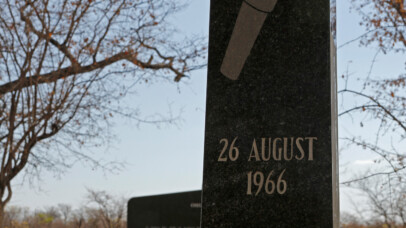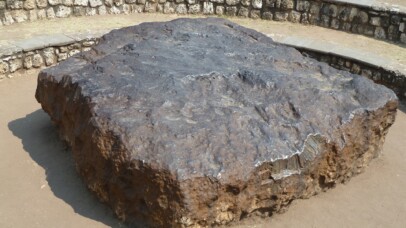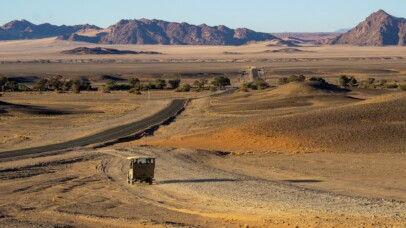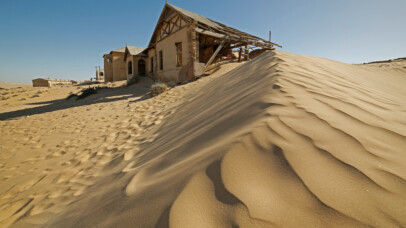Other Popular Sites
Heroes Acre
The Heroes Acre is an official war memorial of the Republic of Namibia. Built into the uninhabited hills 10 kilometres south of the city centre of Windhoek, Heroes’ Acre opened on 26 August 2002 and exists to foster a spirit of patriotism and nationalism and pass on the legacy to the future generations of Namibia.
The Heroes Acre monument is built as an asymmetric polygon with a marble obelisk and a bronze statue of the Unknown Soldier at its centre. The site contains parade grounds and a grandstand for 5000 people.
The burial site consists of 174 tombs, not all currently occupied. At the inauguration of this memorial, nine national heroes and heroines were identified. Some of the included heroes were Mandume Ya Ndemufayo, Hosea Kutako and Hendrik Witbooi.
Hoba Meteorite
The Hoba Meteorite is a meteorite that lies on the farm of the same name, not far from Grootfontein, in the Otjozondjupa Region of Namibia. It is estimated that the meteorite fell approximately 80000 years ago. It was first discovered in 1920 purely by chance by the then owner, ploughing his fields with an ox. The farmer heard a loud metallic scratching sound, and the plough suddenly came to a stop.
The obstruction was excavated and identified as a meteorite. The report confirming this can still be viewed today in the Grootfontein Museum. Due to its large mass, it has never been moved from where it fell.
The meteorite is estimated at more than 60 tones. It is the largest known intact meteorite and about twice as massive as the largest fragment of the Cape York meteorite’s 31-tonne Ahnighito kept in Manhattan.
It is also the most massive naturally occurring piece of iron known on the earth’s surface. The name “Hoba” comes from Khoekhoegowab word meaning “gift”. Following a donation to the government in 1987, a visitor centre was constructed with circular stone access and a seating area. In March 1955, the Hoba Meteorite was declared a national monument. The area around the meteorite was donated to the National Monuments Council in 1987. The meteorite is quite popular with tourists.
Sossusvlei
Undoubtedly the most popular attraction in Southern Namibia and a must-see. Situated in the Namib Desert, Sossusvlei is a large clay and salt pan surrounded by deep orange coloured dunes.
The name ‘Sossusvlei’ is often used in an extended meaning to refer to the surrounding area. The Deadvlei forms part of Sossusvlei and is a top-rated attraction. The Deadvlei used to be an oasis before the Tsauchab River changed its course many years ago.
The remains of blackened skeletal Acacia Trees are all that remain from the oasis and are estimated to be about 900 years old. This scene is one of the most photographed landscapes on the African continent. The surrounding dunes are in a constant state of motion as the fierce desert winds continually alter the texture and shape of these dunes.
During sunrise and sunset, the colours of the sand dunes are constantly changing and provide an opportunity for photographers. Big Daddy Dune is the highest dune in Sossusvlei, with a height of about 325 meters. Directly opposite Big Daddy is another very high dune called Big Mama. Finally, dune 45 is very popular for climbing and is only about 80 meters high.
Kolmanskop Ghost Town
Kolmanskop is a ghost town in the Namib desert, a few kilometres inland from the port town of Lüderitz. It all started in 1908 when the first diamond was found here. News of this spread, and there was a rush.
Lots of Germans settled in this area, and the town of Kolmanskop grew rapidly. Soon after, the German Empire declared the area a ‘Sperrgebiet’ (prohibited area), and exploitation of the diamond field started.
Driven by the enormous wealth of the first diamond miners, the residents built Kolmanskop in the architectural style of a German town, with amenities and institutions including a hospital, ballroom, school, casino as well as the first tram in Africa. Another first was the introduction of an x-ray machine.
However, the town declined when the diamond field slowly exhausted, and richer diamond deposits were discovered further south near the Orange River. Kolmanskop town was abandoned in 1956. Today tourists can undertake a guided tour of this ghost town and learn all about its history and get a fascinating insight into the daily lives of its former inhabitants.






